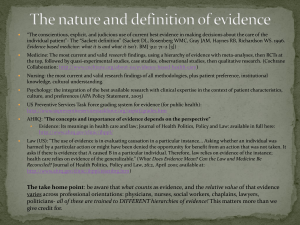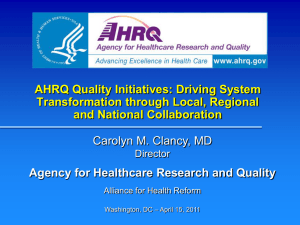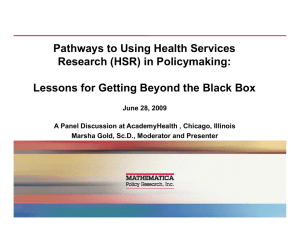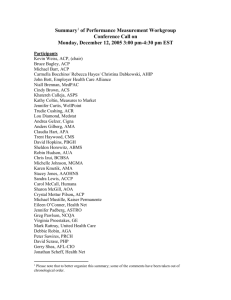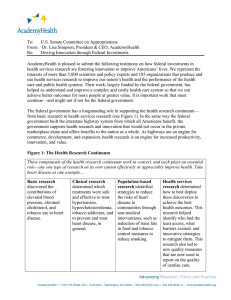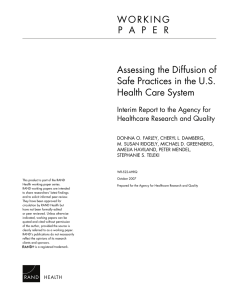OECD’s Health Care Quality OECD s Health Care Quality Indicator Project:
advertisement
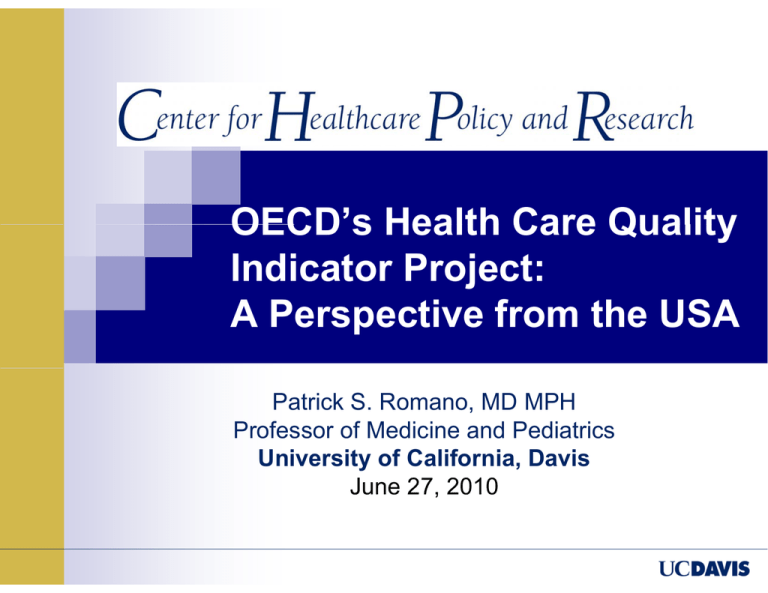
OECD s Health Care Quality OECD’s Indicator Project: A Perspective from the USA Patrick S. Romano, MD MPH Professor of Medicine and Pediatrics University of California, Davis June 27, 2010 Outline: A two-way two way street Contributing C t ib ti measures and tools Sharing evidence regarding validity of measures and tools Informing policy discussions and debates in the USA AHRQ: Data to Information to Action Hospital discharge data are already being collected Hospital discharge data can generate valuable health care information Utilization and Rates of diseases costs of care in populations in hospitals R t off procedures Rates d in populations Information can be used to make decisions Quality and safety of care in hospitals Preventable hospital stays t that th t indicate i di t breakdowns in care AHRQ Quality Indicators (QIs) Developed through contract with UCSF-Stanford Evidence-based Practice Center & UC Davis Use existing hospital discharge data from the Healthcare Cost and Utilization Project: Uniform database for cross cross-State State studies; includes clinical, demographic, and resource use information Represents p all inpatient p discharge g data from 43 participating States, or approximately 90% of all discharges nationwide Standard data elements defined by UHDDS UHDDS, NUBC Incorporate severity adjustment methods, i l di APR including APR-DRGs DRG and d comorbidity bidit groupings i AHRQ QI development process INITIAL EMPRICAL ANALYSES AND DEFINITION LITERATURE REVIEW USER DATA PANEL EVALUATION FURTHER EMPIRICAL ANALYSES REFINED DEFINITION FURTHER REVIEW? FINAL DEFINITION AHRQ Quality Indicators Inpatient QIs Mortality Mortality, Utilization, Volume Prevention QIs (Area Level) A id bl Avoidable Hospitalizations / Other Avoidable Conditions Pediatric QIs Patient Safety Indicators Neonatal QIs Complications, Unexpected Death General uses of the AHRQ QIs Hospital quality improvement efforts Aggregate reporting: National National, state state, regional IIndividual di id l h hospitals i l &h health l h care systems Hospital associations and consortia National Healthcare Quality and Disparities Reports Commonwealth Fund’s Health Performance Initiative Research Tracking quality of care for populations over time and across areas Tracking disparities in care over time and across areas Comparing quality between different types of hospitals or hospital y systems Evaluating impact of interventions to reduce costs or improve quality (e.g., work hours reform, EHR systems, consolidations) General uses of the AHRQ QIs V l b Value based d purchasing h i / pay ffor performance f (P4P) Hospital p level p public reporting p g CMS - Premier Demo Anthem of Virginia The Alliance (Wisconsin) Currently: Statewide public reporting (upcoming slide) Upcoming: CMS Hospital Compare, including Veterans Affairs medical di l centers t ( (upcoming i slide) lid ) International application by the OECD’s Health Care Quality Indicator Project Over half ((60%)) of the US population p p has access to a state public report that uses the AHRQ QIs Washington Oregon Iowa Wisconsin New York Minnesota Illinois Ohi Ohio Vermont Massachusetts Nevada New Jersey California Kentucky Utah Colorado Texas AHRQ QIs appear in public reports in 19 states Florida Okl h Oklahoma AHRQ PQIs endorsed by y OECD Asthma* Ch i Obstructive Chronic Ob t ti P Pulmonary l Di Disease** Congestive Heart Failure* Angina Hypertension* Hypertension Diabetes Short-term Sh t t complications* li ti * Long-term complications Lower-extremity L t it amputation* t ti * Uncontrolled * Published in the 2009 edition of OECD Health at a Glance OECD review of AHRQ PSIs Patient safetyy panel p constituted with 5 members (Dr. John Millar, Chair) 50 indicators from 7 sources submitted for review (US, Canada, Australia) Modified RAND/UCLA Appropriateness Method Panelists rated each indicator on importance and d scientific i tifi soundness d (2 rounds d with ith intervening discussion) Retained indicators with median score >7 (1-9 scale) on both domains; rejected indicators with median score 5 or below on either domain AHRQ PSIs endorsed by y OECD (after review of data limitations) Foreign body left in during procedure (PSI 5) Vascular catheter associated bloodstream infection (PSI 7) Postoperative pulmonary embolism or deep vein thrombosis (PSI 12) Postoperative sepsis (PSI 13) Accidental puncture and laceration (PSI 15) Obstetric trauma -- vaginal delivery with instrument (PSI 18) Obstetric trauma -- vaginal delivery without instrument (PSI 19) Adaptation of AHRQ definitions ICD-9-CM to ICD-10 conversions led by Saskia Drösler under the auspices of the International Methodology Consortium for Coded Health Information (IMECCHI) AHRQ definitions except: Aged 15+ instead of 18+ years Exclusion of day cases (short-stay admissions) Mapping between ICD-9-CM ICD 9 CM and ICD-10 ICD 10 (country(country specific) Procedure coding required country-specific efforts Based on assumptions regarding definition of principal diagnosis, secondary diagnoses that qualify lif ffor reporting, ti etc. t Summary y of PPV estimates from community hospitals in USA 100% 80% %c cases % Other 60% % Exclusions 40% % Miscoding % POA % PPV 20% 0% APL, n=249 PTX, n=205 DVT/PE, Selected n=121 inf, n=191 Postop sepsis, n=164 Postop resp failure, n=609 Informing policy discussions Commonwealth Fund reports and publications Direct testimony in US Congress RWJF/Urban Institute report Concerns about data comparability Can information counteract mythology? Multinational Comparisons of Health Systems y Data,, 2008 Gerard F. Anderson and Patricia Markovich Johns Hopkins University Support for this research was provided by The Commonwealth Fund. The views presented here are those of the authors and not necessarily those of The Commonwealth Fund or its directors, officers, or staff. To learn more about new publications when they become available, visit the Fund’s Web site and register to receive e-mail alerts. Commonwealth Fund pub. no. 1371. International Comparison of Spending on Health 1980 2006 1980–2006 Average spending on health per capita ($US PPP) Total expenditures on health as percent of GDP 16 7000 Australia* Canada France Germany N h l d Netherlands New Zealand Switzerland United Kingdom United States 6000 5000 4000 14 12 10 8 3000 6 Australia Australia* Canada France Germany Netherlands New Zealand Switzerland United Kingdom United States 2000 4 1000 2 0 0 1980 1984 1988 1992 1996 2000 * From Australian Department of Health and Ageing Source: OECD Health Data 2008, “June 2008” 2004 1980 1984 1988 1992 1996 2000 2004 Concerns about data comparability Postoperative PE or Deep Vein Thrombosis N=14 countries, Spearman r=0.670 (p=0.009), R2=0.56 Std. Rate per 100 pts. USA 1.5 1.4 13 1.3 1.2 1.1 1.0 0.9 0.8 0.7 0.6 0.5 0.4 0.3 02 0.2 0.1 NZL GBR IRLE SW DEU BEL NOR CHE DNK ESP CAN ITA PRT 0 1 2 3 4 Mean # of secondary Dx codes 5 6 7 Can information counter mythology? America s health care system is the “best America’s best in the world” Resonates with American pride and “exceptionalism” p Makes health system reform seem threatening undesirable, threatening, undesirable unnecessary (why change what isn’t broken?) But is it true??
